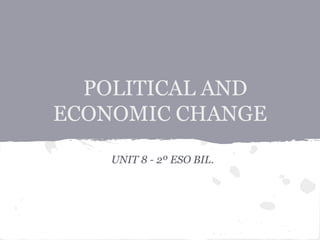
2º bil unit 8 Political and economic change
- 1. POLITICAL AND ECONOMIC CHANGE UNIT 8 - 2º ESO BIL.
- 2. 1- Why did the economy and population grow? THE RECOVERY OF THE POPULATION 14th Century -> demographic crisis. 15th Century -> Slow recovery of the population. 16th Century -> Considerable
- 4. Economic growth -15th and 16th Centuries -> Economy expanded for several reasons: .Population growth .Greater demand of products .More trade due to geographical discoveries -The banking system also improved, and new methods were used: .New payment methods (cheques) .New lending methods (credits) -Cities became important places for economy during these centuries because artisans and trade were concentrated there.
- 5. Activities Exercises 1 and 2 on page 75 and exercise 1 on page 76.
- 6. 2- How did society change? -The three estates from the Middle Ages continued to exist.
- 7. Society changes -Some changes were happening: .Clergy and nobility continued to be the privileged estates. .Peasants continued to have bad conditions, but in Western Europe they improved because they became free in most countries. .A new powerful group emerged, the bourgeoisie. They were rich merchants and bankers and they became influential during this period.
- 8. Activities Exercises 2 and 3 on page 76.
- 9. 3- How did new states emerge? -AUTHORITARIAN MONARCHIES -What is the meaning of AUTHORITARIANISM? a philosophy or system that believes in the necessity of strong authority and strict obedience to it. -During the 15th century European monarchs became authoritarian, that means, they had more power. -They reduced the power of the nobility, the Church, the municipalities and the Parliament. They began confrontations against the authorities and in some cases civil wars broke out.
- 10. -Monarchs had several ways to implement their decisions: .They created a bureaucracy and a centralised administration. (What does bureaucracy mean? It is a system of administration based upon organization into bureaus, division of labour, a hierarchy of authority, etc.; designed to dispose of a large body of work in a routine manner.) .They made the army stronger. .They increased taxes (with the approval of the Parliaments). .They created a diplomatic system. (What is diplomacy? It is the conduct of the relations of one state with another by peaceful means.) -In this way Authoritarian monarchies were born. -The court was permanent from this moment.
- 11. The great kingdoms -Marriage alliances and conquests were the way to create big new States or powers. -These systems were common in Europe, where Authoritarian monarchies developed. -Four of them were the most powerful: .FRANCE, from Charles VII to Francis I. .ENGLAND, from the early 16th century with Henry VIII. .SPAIN, the Catholic Monarchs. .RUSSIA, Ivan the Great.
- 12. Activities Exercise 1 on page 77.
- 13. 4- What were the Spanish Kingdoms? -In the first half of the 15th century there were 5 kingdoms in the Iberian Peninsula: .Crown of Castile .Crown of Aragón .Kingdom of Navarre .Kingdom of Portugal .Nasrid Kingdom of Granada. -CASTILE AND ARAGÓN IN THE 15th CENTURY: .Crown of Castile: .Nobility revolts / weak kings .Henry IV died in 1474 -> Civil War between the supporters of her sister, Isabella, and of her daughter, Joanna. .Isabella won and was proclaimed Queen of Castile in 1479.
- 14. .Crown of Aragón: .In 1410 Martin I died with no heirs ->Compromise of Caspe -> Ferdinand of Antequera was chosen king by the nobles of the Crown of Aragón -> that meant a change of dynasty: Trastámara. -DYNASTIC UNION: .In 1469 Isabella married Ferdinand, heir of the Crown of Aragón. .In 1474 after Henry IV's death Isabella proclaimed herself queen (after winning the civil war she was totally recognised). .In 1479 Ferdinand became king of Aragón. They united and governed both Crowns, but kept its own institutions. They were called the Catholic Monarchs. .In 1504 Isabella died and her daughter Joanna the Mad inherited the Crown of Castile. Queen Joanna was insane, so her father ruled for her as regent. .Charles I (son of Joanna) inherited both Crowns in 1516.
- 17. Charles I Joanna the Mad and Philip the Handsome
- 18. 5- How did the Catholic Monarchs rule? -DOMESTIC POLICIES -The Catholic Monarchs established different measures to bring peace to their kingdoms and to govern them with authority: .Holy Brotherhood .Royal Council .Corregidores .Royal treasury .Professional army. -TERRITORIAL EXPANSION -In the Iberian Peninsula: Granada (1492) and Navarre (1512). -Outside: Naples, cities in North Africa, Canary Islands, and the Americas.
- 20. 5- How did the Catholic Monarchs rule? -RELIGIOUS UNITY -The Catholic Monarchs wanted religious unification for their kingdoms. -In 1478 they founded the Tribunal of the Inquisition to prosecute heretics. -They published two Royal Decrees establishing the expulsion or conversion of the Jews first (1492) and the
- 21. Tribunal of the Inquisition
- 23. Expulsion of the Jews and Mudejars
- 24. Activities Exercise 1 on page 79. Exercise 2 on page 80. Exercises 4 and 5 on page 81. TERMS for next Thursday 14th March.
- 25. The End
